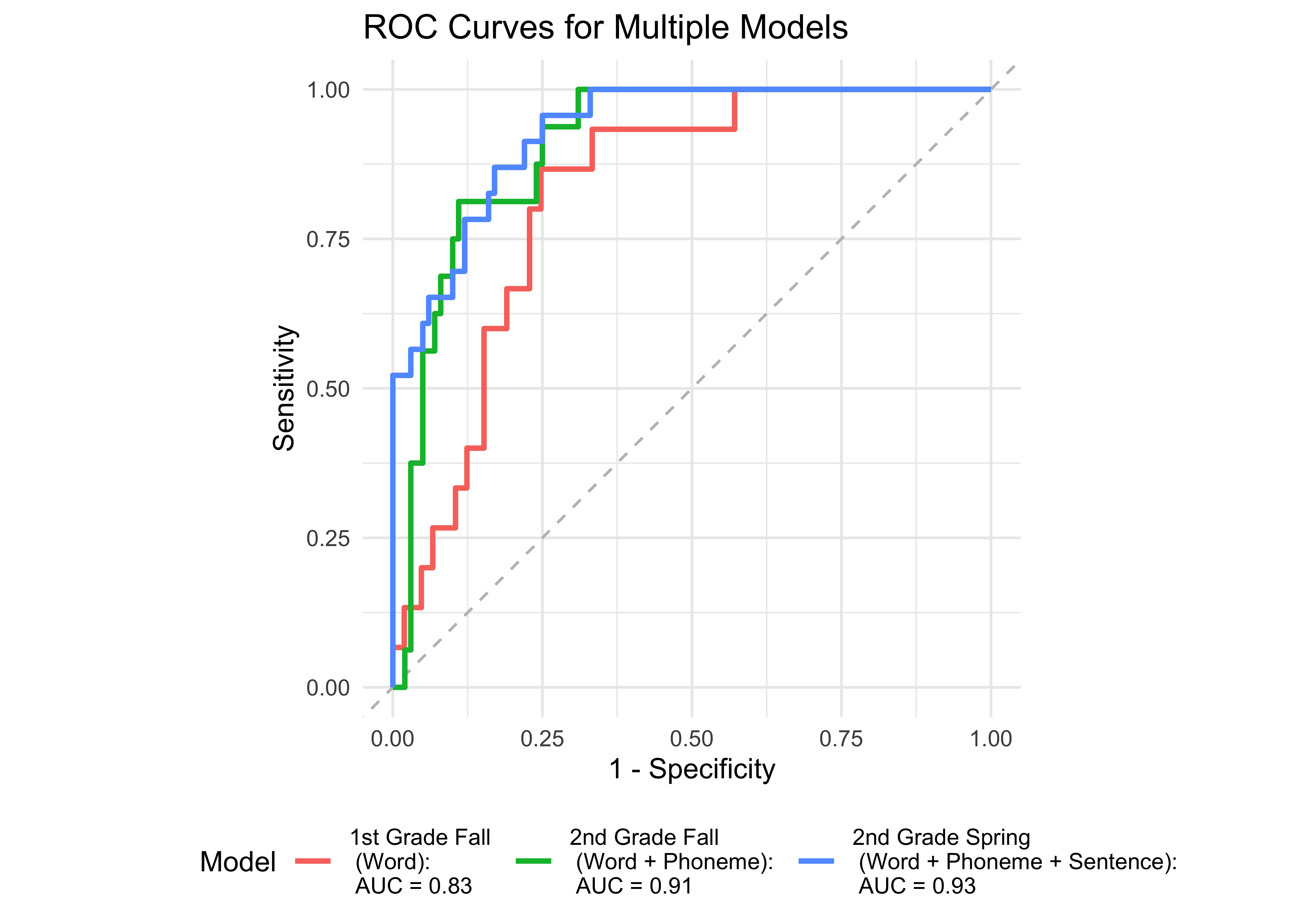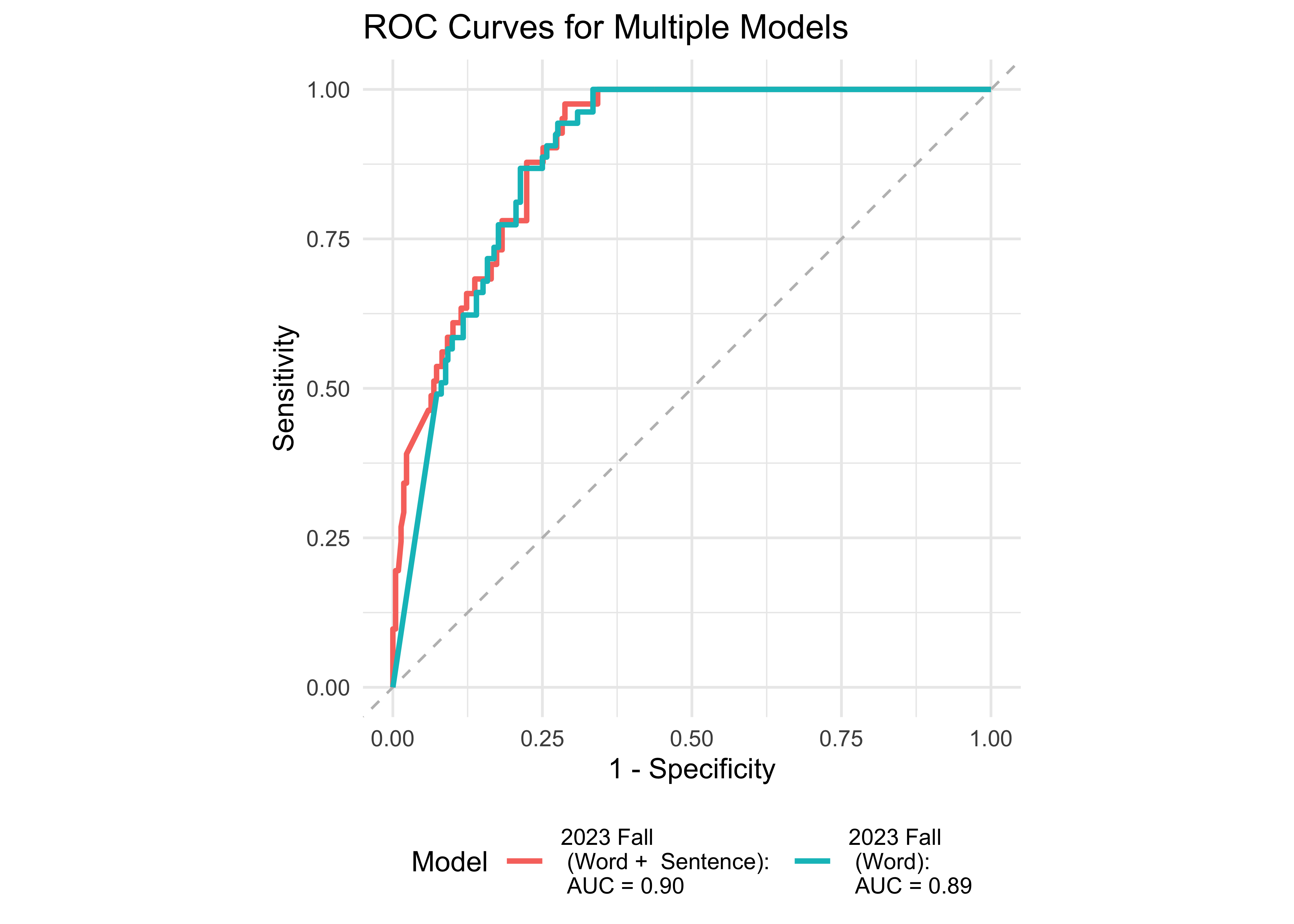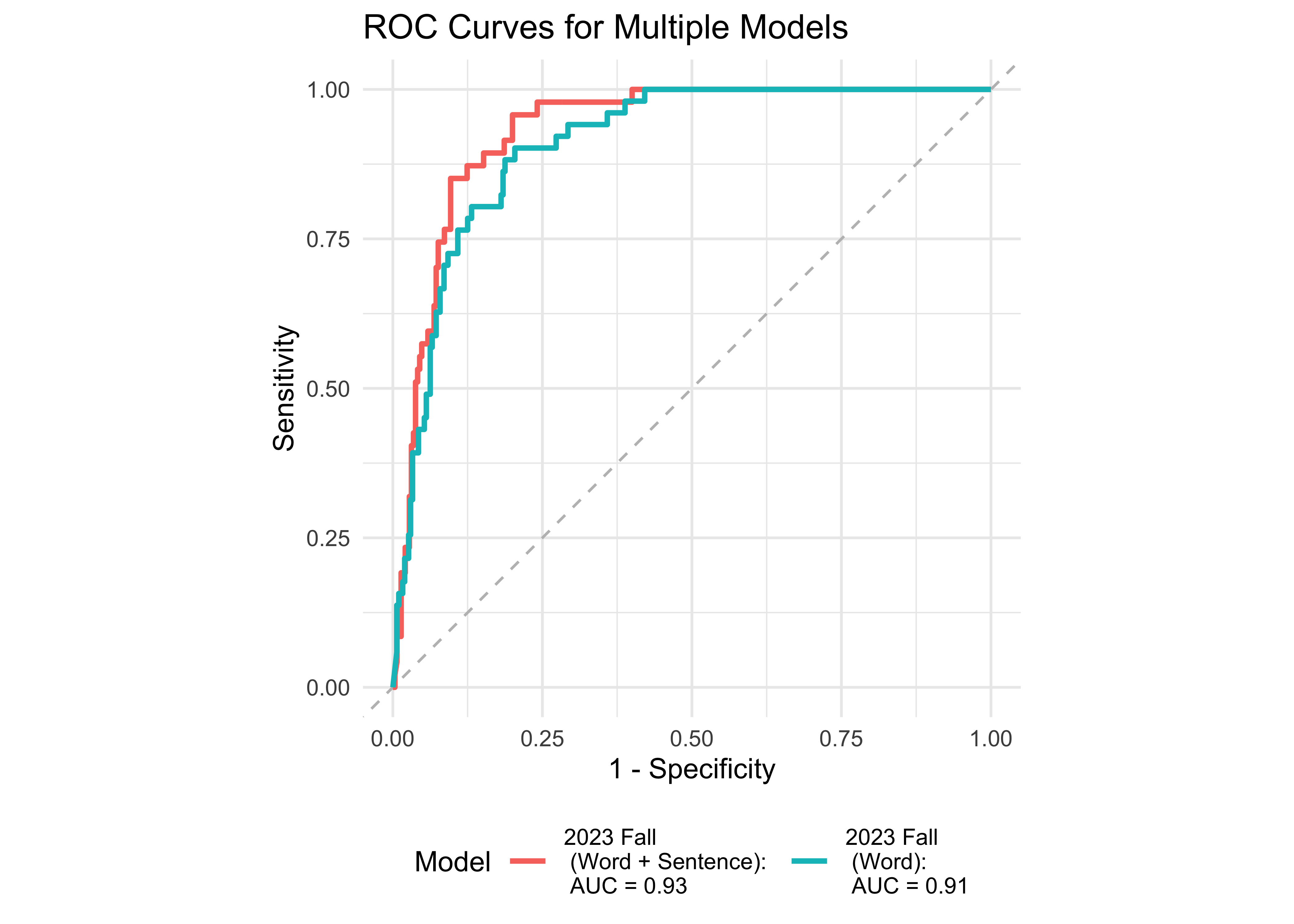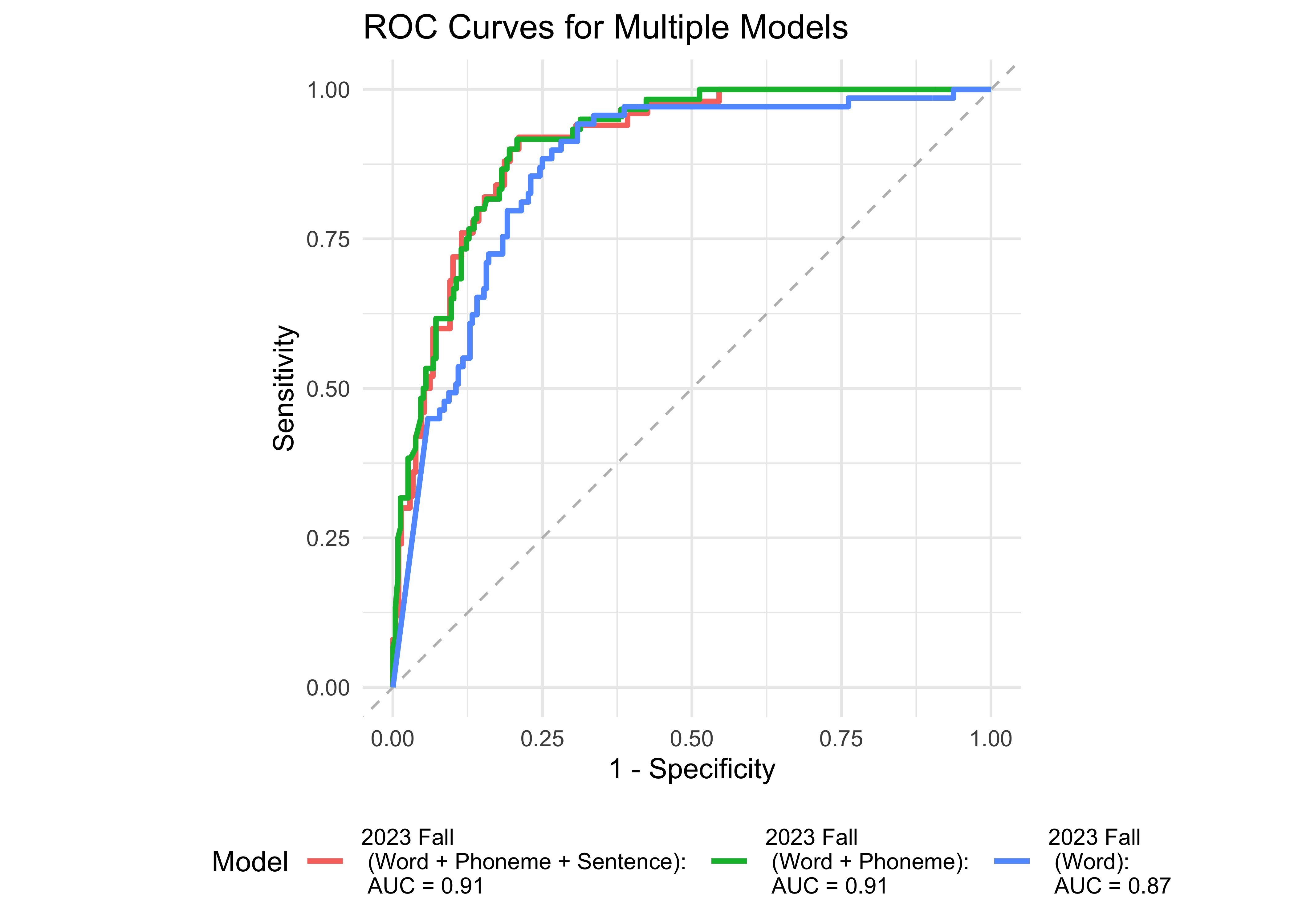| ROAR Measure | ROAR Administration | N | Correlation |
|---|---|---|---|
| ROAR Word | Fall 2021 | 120 | 0.685 |
| ROAR Word | Spring 2022 | 120 | 0.632 |
| ROAR Word | Fall 2022 | 125 | 0.629 |
| ROAR Word | Spring 2023 | 141 | 0.738 |
| ROAR Word | Fall 2023 | 165 | 0.744 |
| ROAR Phoneme | Spring 2022 | 74 | 0.408 |
| ROAR Phoneme | Fall 2022 | 117 | 0.539 |
| ROAR Phoneme | Spring 2023 | 133 | 0.557 |
| ROAR Phoneme | Fall 2023 | 166 | 0.526 |
| ROAR Sentence | Spring 2023 | 125 | 0.715 |
| ROAR Sentence | Fall 2023 | 164 | 0.697 |
30 Predictive Validity
30.1 Background: Published studies
Predictive validity of ROAR Foundational Reading Skills (see Section 9.1 for additional information on ROAR Foundational Reading Skills) was first reported by (Gijbels, Burkhardt, and Ma 2024). Gijbels, Burkhardt, and Ma (2024) examined the classification accuracy of ROAR Foundational Reading Skills administered in 1st grade for classifying students who were deemed “at risk” for reading difficulties based on the Fountas and Pinnell (F&P) Benchmark Assessment 8 months later in the fall of 2nd grade. This study included N=130 1st grade students from a public school in California. Students completed ROAR Foundational Reading Skills measures in their classroom and F&P Benchmark Assessments were administered by their classroom teachers. A Generalized Additive Model (GAM) (S. Wood and Wood 2015; S. N. Wood 2017) based on ROAR-Phoneme achieved an AUC=0.70, ROAR-Word achieved and AUC=0.83, and a GAM with ROAR-Phoneme and ROAR-Word achieved an AUC=0.84. The prediction accuracy of ROAR-Phoneme and ROAR-Word for reading skills assessed the following school year with individually-admininstered assessments demonstrated the promise of ROAR as a quick and automated screener.
30.2 Longitudinal studies of grades 1-3
We ran 2 additional studies to assess the predictive validity of ROAR Foundational Reading Skills
- Two-year longitudinal study of predictive validity: In a large California school district, all the 1st grade classrooms were administered ROAR Foundational Reading Skills measures three times per year and were followed longitudinally for 2 years. In the fall of 3rd grade, each student was individually administered the Woodcock Johnson Basic Reading Skills (WJ BRS) Composite Index. Based on this criterion measure, we assessed sensitivity and specificity of ROAR at each timepoint for predicting students who were classified as struggling readers with indications of dyslexia. Additionally we report prediction accuracy based on BRS as a continuous measure.
- Fall to spring prediction in 1st, 2nd, and 3rd grade: In a second study we assessed predictive validity of ROAR Foundational Reading Skills measures admininstered in the Fall and Winter for predicting individually administered FAST™ earlyReading and FAST™ CBMreading in the Spring (for concurrent validity of ROAR Spring assessment see Chapter 28).
For each study we report Area Under the Curve (AUC), Sensitivity, and Specificity as measures of classification accuracy and Pearson’s \(\rho\) as a measure of prediction accuracy for continuous criterion measures.
30.2.1 Study 1: Two-year longitudinal study with Woodcock Johnson’s Basic Reading Skills (BRS) as the criterion
We implemented our ROAR measures beginning in the first grade. As shown in Table 30.1, ROAR-Word administered in first grade consistently predicts third-grade WJ-BRS outcomes.The correlation between ROAR-Word and WJ-BRS strengthens over time. Table 30.2 demonstrates that ROAR measures can predict reading fluency as early as the first grade, with ROAR-Sentence being the most relevant predictor. The highlighted rows indicate the concurrent validity, where the ROAR measures and WJ-BRS were administered within the same month.
| ROAR Measure | ROAR Administration | N | Correlation |
|---|---|---|---|
| ROAR-Word | Fall 2021 | 120 | 0.703 |
| ROAR-Word | Spring 2022 | 120 | 0.733 |
| ROAR-Word | Fall 2022 | 125 | 0.672 |
| ROAR-Word | Spring 2023 | 141 | 0.713 |
| ROAR-Word | Fall 2023 | 165 | 0.737 |
| ROAR-Phoneme | Spring 2022 | 74 | 0.336 |
| ROAR-Phoneme | Fall 2022 | 117 | 0.486 |
| ROAR-Phoneme | Spring 2023 | 133 | 0.574 |
| ROAR-Phoneme | Fall 2023 | 166 | 0.513 |
| ROAR-Sentence | Spring 2023 | 125 | 0.817 |
| ROAR-Sentence | Fall 2023 | 164 | 0.831 |
Based on the WJ-BRS, 32 out of 170 students were identified as high-risk or at-risk struggling readers (scoring below the 50th percentile of the WJ-BRS norms). We treated this classification as the true score. Next, we examined the prediction accuracy of a logistic regression model using ROAR measures taken in the previous year. Figure 30.1 provides further evidence supporting the high sensitivity and specificity of ROAR-Word in predicting dyslexia classification with a lead time of two years.

30.2.2 Study 2: Fall to Spring prediction of FAST™ earlyReading and FAST™ CBMreading
Table 30.3 demonstrates that ROAR-Word in the Fall, among ROAR measures, is the strongest predictor of FAST™ CBMreading performance in the Spring for 1st graders. For 2nd and 3rd graders, both ROAR-Word and ROAR-Sentence are strong predictors of FAST™ CBMreading outcomes. Additionally, Table 30.4 provides further evidence that ROAR-Word in the Fall is a robust predictor of FAST™ earlyReading performance in the Spring. The highlighted rows indicate the concurrent validity, where the ROAR measures and FAST™ were administered within the same month.
| Grade | ROAR Measure | ROAR Administration | N | Correlation |
|---|---|---|---|---|
| 1 | ROAR-Word | Fall 2023 | 313 | 0.725 |
| 1 | ROAR-Word | 2024 Winter | 336 | 0.782 |
| 1 | ROAR-Word | Spring 2024 | 306 | 0.777 |
| 1 | ROAR-Phoneme | Fall 2023 | 305 | 0.589 |
| 1 | ROAR-Phoneme | 2024 Winter | 352 | 0.647 |
| 1 | ROAR-Phoneme | Spring 2024 | 332 | 0.604 |
| 1 | ROAR-Sentence | Fall 2023 | 263 | 0.647 |
| 1 | ROAR-Sentence | 2024 Winter | 345 | 0.791 |
| 1 | ROAR-Sentence | Spring 2024 | 307 | 0.796 |
| 2 | ROAR-Word | Fall 2023 | 342 | 0.748 |
| 2 | ROAR-Word | 2024 Winter | 338 | 0.705 |
| 2 | ROAR-Word | Spring 2024 | 319 | 0.678 |
| 2 | ROAR-Phoneme | Fall 2023 | 350 | 0.500 |
| 2 | ROAR-Phoneme | 2024 Winter | 150 | 0.404 |
| 2 | ROAR-Sentence | Fall 2023 | 333 | 0.765 |
| 2 | ROAR-Sentence | 2024 Winter | 330 | 0.784 |
| 2 | ROAR-Sentence | Spring 2024 | 322 | 0.780 |
| 3 | ROAR-Word | Fall 2023 | 192 | 0.577 |
| 3 | ROAR-Word | 2024 Winter | 163 | 0.583 |
| 3 | ROAR-Word | Spring 2024 | 150 | 0.590 |
| 3 | ROAR-Phoneme | Fall 2023 | 193 | 0.363 |
| 3 | ROAR-Phoneme | 2024 Winter | 99 | 0.399 |
| 3 | ROAR-Sentence | Fall 2023 | 190 | 0.587 |
| 3 | ROAR-Sentence | 2024 Winter | 163 | 0.600 |
| 3 | ROAR-Sentence | Spring 2024 | 149 | 0.594 |
| Grade | ROAR Measure | ROAR Administration | N | Correlation |
|---|---|---|---|---|
| 1 | ROAR-Word | Fall 2023 | 313 | 0.725 |
| 1 | ROAR-Word | 2024 Winter | 335 | 0.780 |
| 1 | ROAR-Word | Spring 2024 | 306 | 0.777 |
| 1 | ROAR-Phoneme | Fall 2023 | 305 | 0.589 |
| 1 | ROAR-Phoneme | 2024 Winter | 351 | 0.645 |
| 1 | ROAR-Phoneme | Spring 2024 | 331 | 0.601 |
| 1 | ROAR-Sentence | Fall 2023 | 263 | 0.647 |
| 1 | ROAR-Sentence | 2024 Winter | 345 | 0.791 |
| 1 | ROAR-Sentence | Spring 2024 | 307 | 0.796 |
We examined the prediction accuracy of a logistic regression model using ROAR measures from Fall 2023 to predict the FAST™ classification (low risk vs. some risk and high risk) in Spring 2024. Figure 30.2 provides evidence supporting the high sensitivity and specificity of ROAR-Word in predicting dyslexia classification in both 1st and 2nd grades. Additionally, ROAR-Phoneme is more useful in 1st grade and ROAR-Sentence proves to be more useful in 2nd grade.



We examined the prediction accuracy of a logistic regression model using ROAR measures from Fall 2023 to predict the FAST™ classification (low risk vs. some risk and high risk) in Spring 2024. Figure 30.3 provides evidence supporting the high sensitivity and specificity of ROAR-Word in predicting dyslexia risk classification in 3rd grade.
